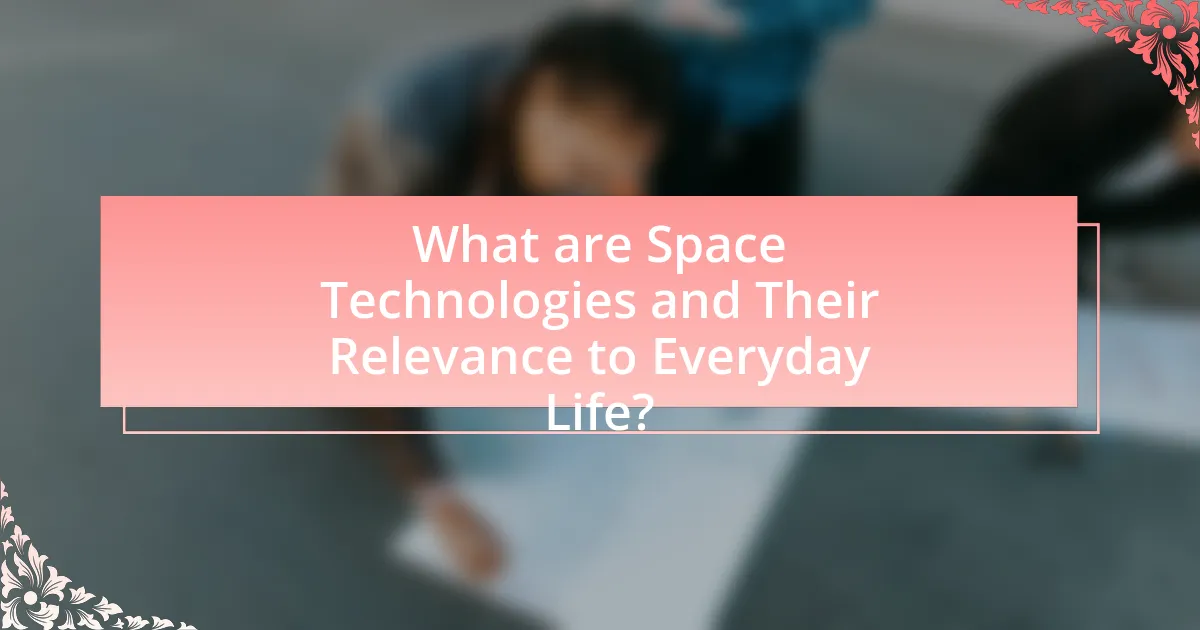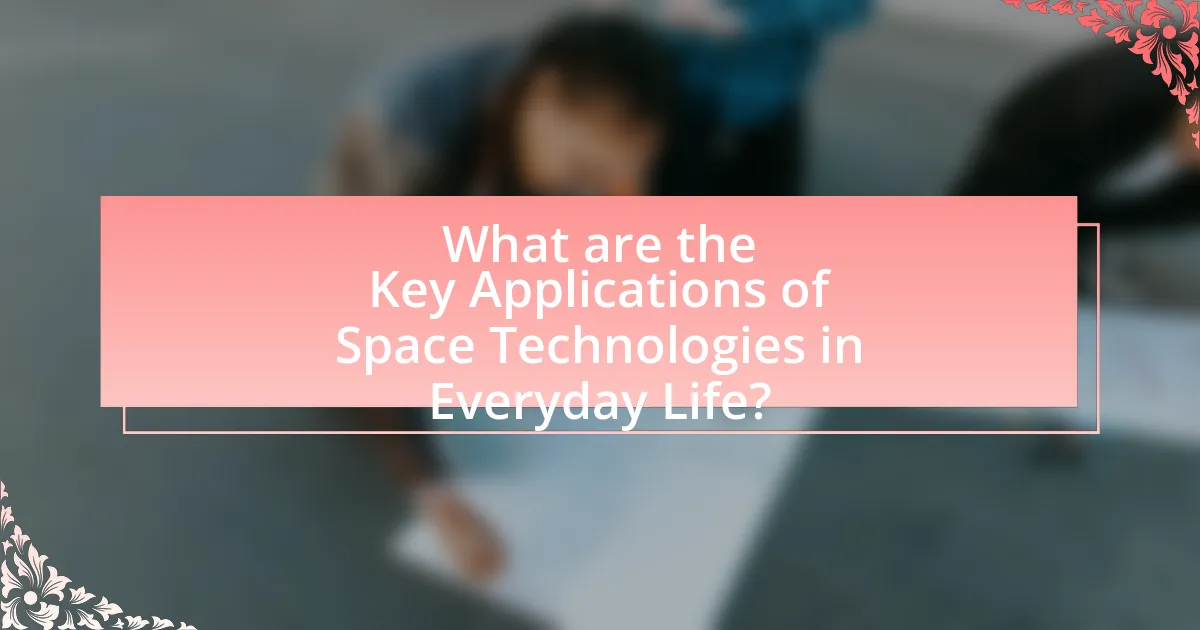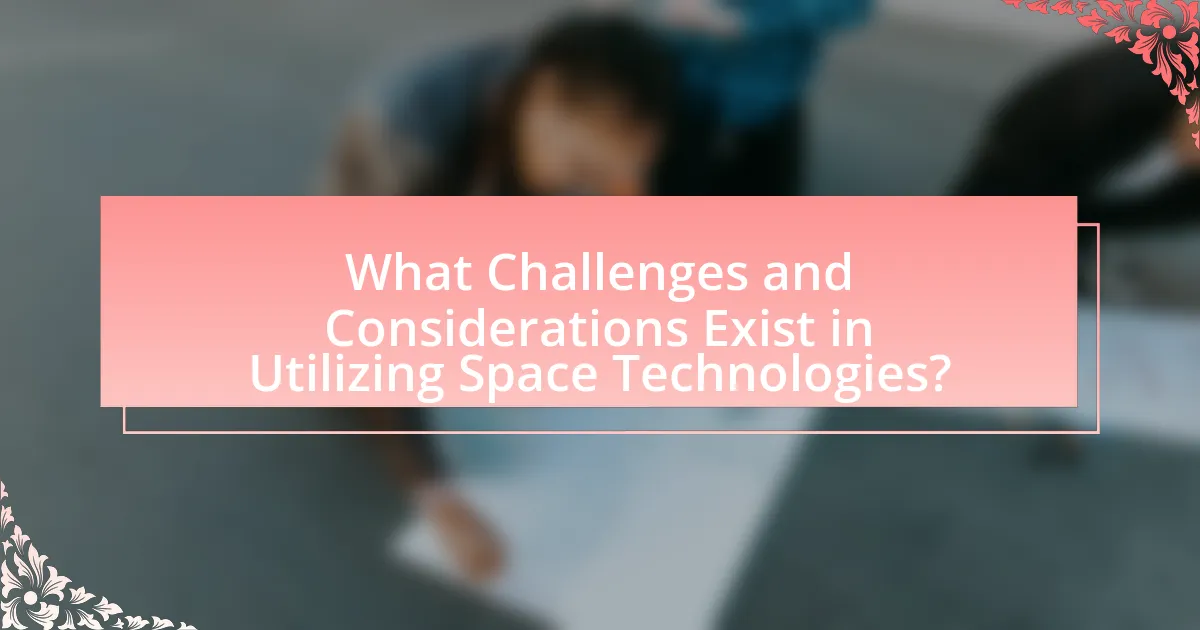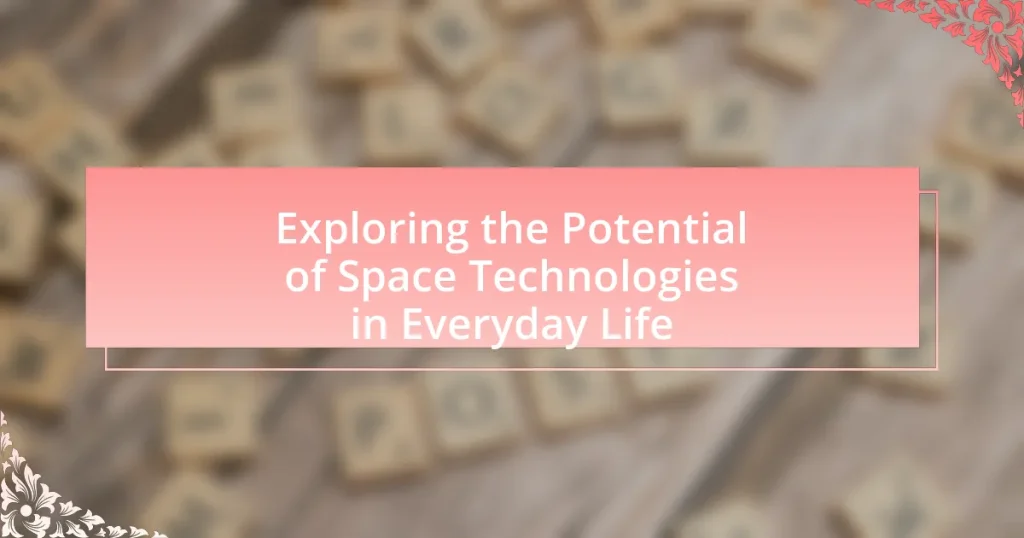Space technologies refer to the tools and systems developed for space exploration and satellite operations that significantly influence everyday life. This article explores the various applications of space technologies, including satellite communications, GPS navigation, weather forecasting, and Earth observation, highlighting their impact on daily activities, convenience, and efficiency. It also discusses the societal benefits of integrating these technologies, their contributions to sustainability, and the challenges associated with their utilization, such as costs, regulatory hurdles, and environmental concerns. Additionally, the article emphasizes the importance of responsible use and public awareness in maximizing the potential of space technologies for enhancing life on Earth.

What are Space Technologies and Their Relevance to Everyday Life?
Space technologies encompass a range of tools and systems developed for space exploration and satellite operations, which significantly impact everyday life. These technologies include satellite communications, GPS navigation, weather forecasting, and Earth observation, all of which enhance daily activities and decision-making. For instance, GPS technology, derived from satellite systems, is essential for navigation in vehicles and smartphones, facilitating efficient travel and logistics. Additionally, satellite imagery aids in agriculture by providing data on crop health and land use, thereby improving food production. Furthermore, advancements in materials and engineering from space missions have led to innovations in various sectors, including healthcare and consumer electronics. The relevance of space technologies is evident in their integration into daily routines, enhancing connectivity, safety, and efficiency across multiple domains.
How do Space Technologies impact daily activities?
Space technologies significantly impact daily activities by enhancing communication, navigation, and environmental monitoring. For instance, satellite communication enables global connectivity, allowing people to make calls, access the internet, and stream content seamlessly. GPS technology, which relies on satellite systems, provides accurate navigation for personal and commercial use, improving travel efficiency and safety. Additionally, satellites monitor weather patterns and natural disasters, providing critical data that informs public safety measures and agricultural practices. According to the National Oceanic and Atmospheric Administration (NOAA), satellite data is essential for accurate weather forecasting, which affects daily decisions for millions of people.
What specific technologies are derived from space exploration?
Specific technologies derived from space exploration include satellite communication, GPS technology, and advanced materials. Satellite communication enables global broadcasting and internet services, while GPS technology provides precise location tracking, essential for navigation in various applications. Advanced materials, such as heat-resistant alloys and lightweight composites, have been developed for spacecraft and are now used in industries like automotive and construction. These technologies demonstrate the direct impact of space exploration on everyday life, enhancing communication, navigation, and material performance.
How do these technologies enhance convenience and efficiency?
Space technologies enhance convenience and efficiency by enabling real-time data access and improving communication systems. For instance, satellite technology facilitates GPS navigation, allowing users to find optimal routes quickly, which saves time and reduces fuel consumption. Additionally, advancements in satellite imagery provide critical information for agriculture, enabling farmers to monitor crop health and optimize resource use, thereby increasing productivity. These technologies streamline processes across various sectors, leading to significant time savings and resource efficiency.
Why is it important to explore the potential of Space Technologies?
Exploring the potential of space technologies is crucial for advancing scientific knowledge and improving life on Earth. Space technologies contribute to innovations in communication, weather forecasting, and disaster management, enhancing global connectivity and safety. For instance, satellite technology enables precise weather predictions, which can save lives and reduce economic losses during natural disasters. Additionally, advancements in space exploration drive technological progress, leading to developments in materials science, robotics, and energy solutions that benefit various industries. The investment in space technologies also stimulates economic growth, creating jobs and fostering international collaboration in research and development.
What are the societal benefits of integrating space technologies?
Integrating space technologies offers significant societal benefits, including advancements in communication, environmental monitoring, and disaster management. For instance, satellite communication enhances global connectivity, enabling access to information and services in remote areas, which is crucial for education and economic development. Additionally, Earth observation satellites provide critical data for monitoring climate change, natural resources, and urban planning, helping societies make informed decisions. Furthermore, space technologies play a vital role in disaster response; for example, satellite imagery assists in assessing damage and coordinating relief efforts during natural disasters, ultimately saving lives and resources. These applications demonstrate how space technologies contribute to societal well-being and resilience.
How can space technologies contribute to sustainability?
Space technologies contribute to sustainability by enabling efficient resource management, monitoring environmental changes, and enhancing disaster response. For instance, satellite imagery allows for precise tracking of deforestation, urban sprawl, and agricultural practices, which aids in sustainable land use planning. According to a report by the European Space Agency, Earth observation satellites provide critical data that supports climate change mitigation efforts and helps countries meet their sustainability goals. Additionally, technologies such as GPS and remote sensing improve logistics and transportation efficiency, reducing carbon footprints.

What are the Key Applications of Space Technologies in Everyday Life?
Key applications of space technologies in everyday life include satellite communications, GPS navigation, weather forecasting, and Earth observation. Satellite communications enable global connectivity for television, internet, and phone services, impacting billions of users. GPS navigation, derived from satellite technology, provides precise location data for navigation systems used in vehicles and smartphones, enhancing travel efficiency. Weather forecasting relies on data collected from satellites, allowing for accurate predictions that inform public safety and agricultural planning. Earth observation satellites monitor environmental changes, aiding in disaster management and resource management. These applications demonstrate the integral role of space technologies in enhancing daily activities and decision-making processes.
How is satellite technology used in communication?
Satellite technology is used in communication by enabling the transmission of data, voice, and video signals over long distances through space. Satellites facilitate global communication networks, allowing for services such as television broadcasting, internet access, and mobile phone connectivity. For instance, geostationary satellites orbit at approximately 35,786 kilometers above the Earth, providing consistent coverage to specific regions, which is essential for direct-to-home television services and broadband internet. According to the International Telecommunication Union, as of 2021, over 1,800 satellites were actively providing communication services, demonstrating the critical role of satellite technology in modern communication infrastructure.
What role do satellites play in global positioning systems?
Satellites are essential components of global positioning systems (GPS) as they provide the necessary signals for determining precise locations on Earth. Each GPS satellite continuously transmits signals that include its location and the exact time the signals were sent. GPS receivers on the ground use these signals from multiple satellites to triangulate their position through a process called trilateration. For accurate positioning, at least four satellites are typically required, as this allows the receiver to calculate its latitude, longitude, and altitude. The effectiveness of GPS is supported by a constellation of at least 24 operational satellites, which ensures global coverage and reliable positioning data for various applications, including navigation, mapping, and timing services.
How do satellites enhance internet connectivity in remote areas?
Satellites enhance internet connectivity in remote areas by providing direct communication links that bypass traditional ground infrastructure. This capability allows users in isolated locations to access high-speed internet services, which would otherwise be unavailable due to geographical barriers. For instance, satellite internet systems, such as those operated by SpaceX’s Starlink, utilize low Earth orbit satellites to deliver broadband services with latency as low as 20 milliseconds, significantly improving connectivity for users in rural and underserved regions. This technology enables not only basic internet access but also supports applications like telemedicine, online education, and remote work, thereby bridging the digital divide.
What impact do space technologies have on healthcare?
Space technologies significantly enhance healthcare by improving medical imaging, telemedicine, and data analysis. For instance, satellite technology enables remote monitoring of patients, allowing healthcare providers to deliver care to underserved areas. Additionally, advancements in imaging technologies, originally developed for space exploration, have led to better diagnostic tools such as MRI and CT scans. According to a study by the National Aeronautics and Space Administration (NASA), technologies like telehealth have increased access to medical services, particularly in rural regions, demonstrating a direct correlation between space innovations and improved healthcare outcomes.
How are telemedicine and remote diagnostics influenced by space tech?
Telemedicine and remote diagnostics are significantly influenced by space technology through advancements in satellite communication and data transmission. Satellite systems enable high-speed internet access in remote areas, facilitating real-time consultations and diagnostics for patients who are geographically isolated. For instance, NASA’s development of the Tracking and Data Relay Satellite System (TDRSS) has improved communication capabilities, allowing healthcare providers to connect with patients in rural or underserved regions. Additionally, space-based imaging technologies, such as those used in Earth observation, can assist in monitoring environmental health factors that impact patient care. These applications demonstrate how space technology enhances the accessibility and effectiveness of telemedicine and remote diagnostics.
What advancements in medical imaging have resulted from space research?
Advancements in medical imaging resulting from space research include the development of advanced imaging technologies such as MRI and CT scans, which have benefited from techniques originally designed for satellite imaging. For instance, the algorithms used in processing images from space telescopes have been adapted to enhance the clarity and precision of medical scans. NASA’s work on digital imaging and signal processing has directly influenced the improvement of imaging techniques, allowing for better diagnosis and treatment planning in healthcare. These advancements have led to more accurate detection of diseases, such as cancer, by providing clearer images and reducing the time needed for diagnosis.

What Challenges and Considerations Exist in Utilizing Space Technologies?
Utilizing space technologies presents challenges such as high costs, regulatory hurdles, and technical complexities. High costs are evident in the significant financial investment required for research, development, and deployment of space systems, with estimates indicating that launching a satellite can exceed tens of millions of dollars. Regulatory hurdles arise from the need to comply with international treaties and national laws governing space activities, which can delay projects and increase expenses. Technical complexities include the challenges of developing reliable systems that can operate in harsh space environments, as evidenced by the failure rates of early satellite missions, which were often above 50%. These factors collectively hinder the widespread adoption and integration of space technologies into everyday life.
What are the potential risks associated with space technology integration?
The potential risks associated with space technology integration include cybersecurity threats, space debris, and regulatory challenges. Cybersecurity threats arise as space systems become interconnected, making them vulnerable to hacking and data breaches, which can compromise sensitive information and operational integrity. Space debris poses a significant risk to both manned and unmanned spacecraft, with thousands of pieces of debris orbiting Earth, increasing the likelihood of collisions that can damage or destroy satellites. Regulatory challenges stem from the need for international cooperation and compliance with various space treaties, which can complicate the integration process and lead to conflicts over space resource utilization.
How can data privacy be affected by satellite surveillance?
Satellite surveillance can significantly affect data privacy by enabling the collection of detailed information about individuals and their activities without consent. This technology allows for the monitoring of personal movements, behaviors, and even communications, leading to potential violations of privacy rights. For instance, high-resolution imagery can capture images of private properties and public spaces, revealing sensitive information about individuals’ daily lives. According to a report by the Electronic Frontier Foundation, satellite imagery has been used to track individuals and monitor protests, raising concerns about government surveillance and the erosion of civil liberties.
What are the environmental concerns related to space debris?
Space debris poses significant environmental concerns primarily due to its potential to collide with operational satellites and spacecraft, leading to further debris generation and risks to space missions. The increasing amount of debris, estimated to exceed 34,000 pieces larger than 10 cm, threatens not only the safety of current space operations but also the long-term sustainability of space activities. Additionally, the uncontrolled re-entry of larger debris pieces can result in hazardous materials falling to Earth, posing risks to both human life and the environment. The European Space Agency has reported that collisions could create a cascade effect, known as the Kessler Syndrome, where the density of objects in low Earth orbit increases to a point where space becomes unusable.
How can we ensure the responsible use of Space Technologies?
To ensure the responsible use of space technologies, it is essential to establish and enforce international regulations and guidelines that govern their development and deployment. These regulations can include frameworks like the Outer Space Treaty, which promotes the peaceful use of outer space and encourages cooperation among nations. Additionally, implementing best practices for satellite launches, debris mitigation, and data sharing can help minimize risks associated with space activities. For instance, the European Space Agency’s Space Debris Mitigation Guidelines provide specific measures to reduce the creation of space debris, which is crucial for maintaining a sustainable space environment.
What regulations are in place to govern space technology applications?
Regulations governing space technology applications include international treaties, national laws, and industry standards. The Outer Space Treaty of 1967, ratified by over 100 countries, establishes fundamental principles for the use of outer space, including the prohibition of nuclear weapons in space and the requirement for states to avoid harmful interference with other nations’ space activities. Additionally, the U.S. Federal Aviation Administration (FAA) regulates commercial space launches and reentries under the Commercial Space Launch Act, ensuring safety and compliance with federal standards. The European Space Agency (ESA) also has its own regulatory framework to oversee space activities within its member states. These regulations are essential for promoting responsible use of space technology and ensuring the safety of both space operations and the environment.
How can public awareness and education improve technology adoption?
Public awareness and education can significantly improve technology adoption by increasing understanding and reducing resistance to new technologies. When individuals are informed about the benefits and functionalities of technologies, such as space technologies, they are more likely to embrace them. For instance, a study by the Pew Research Center found that 87% of Americans believe that space exploration is essential for technological advancement, indicating a strong public interest that can drive adoption. Furthermore, educational initiatives that demonstrate practical applications of space technologies, like satellite communication or GPS, can enhance user confidence and encourage integration into daily life. This combination of awareness and education fosters a more informed public that is willing to adopt and utilize new technologies effectively.
What are some practical tips for leveraging Space Technologies in daily life?
Practical tips for leveraging space technologies in daily life include utilizing satellite navigation systems for accurate location tracking and route planning. For instance, GPS technology, which relies on a network of satellites, enhances navigation for personal travel and logistics, improving efficiency and safety. Additionally, accessing weather forecasting services that use satellite data can help individuals plan outdoor activities and manage agricultural practices effectively. Furthermore, employing satellite-based communication tools, such as satellite phones and internet services, ensures connectivity in remote areas where traditional networks may be unreliable. These applications demonstrate how space technologies can enhance daily activities and decision-making processes.


